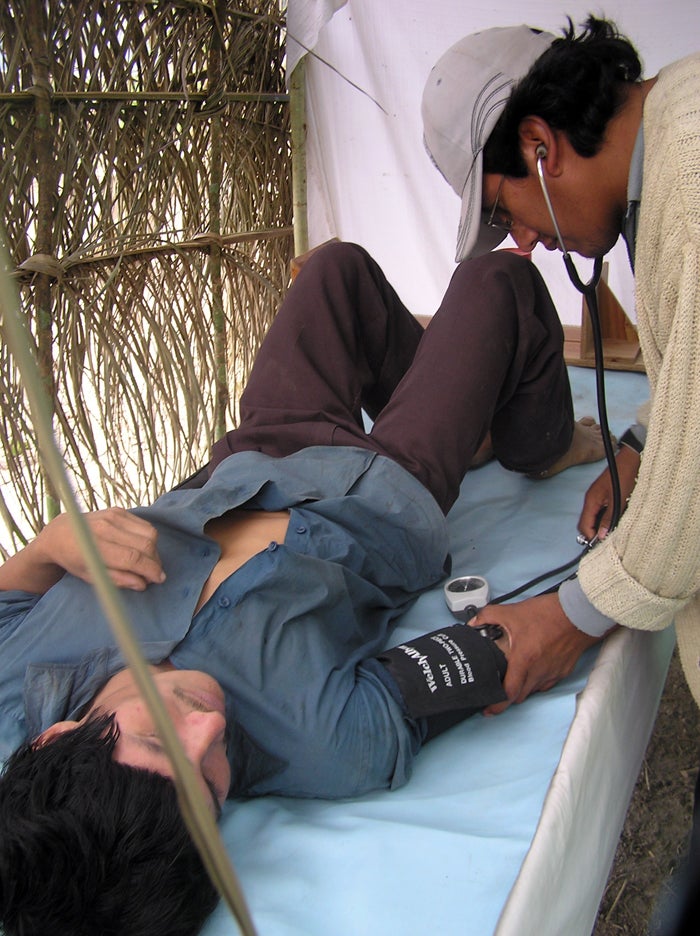
Hunter-Gatherers, Forager-Horticulturalists Demonstrate Minimal Hypertension and Lower Risk of Heart Disease

While age-related increases in blood pressure –– and the associated risk of atherosclerosis –– are commonplace in the United States, other developed countries, and now in the developing world, that does not seem to be the case among hunter-gatherers and forager-horticulturists, according to researchers at UC Santa Barbara. Their findings appear in the current issue of Hypertension, the journal of the American Heart Association.
Age-related increases in blood pressure have been observed in almost every population, except among hunter-gatherers, farmers, and pastoralists who have traditional lives and grow only what they need for survival. "Surprisingly, hypertension, heart disease, and stroke aren't necessarily inevitable with age," said Michael Gurven, professor of anthropology at UCSB and lead author of the study. Gurven is also director of the campus's Integrative Anthropological Sciences Unit and the Broom Demography Center's Biodemography and Evolution Unit.
High blood pressure and atherosclerosis –– a disease in which arteries stiffen and fill with plaque –– increase risks of heart attack, stroke, kidney disease, and even death.
"We can learn from today's hunters-gatherers and horticulturalists," Gurven continued. "The conditions in which they live are more similar to those likely experienced by our ancestors than those we find ourselves in today –– greater exposure to pathogens, active lifestyle, high fertility, and traditional diet. The human body may be better adapted to those conditions, so studying chronic diseases in these populations can be very insightful."
Gurven's team followed 2,296 indigenous adults in 82 Tsimane villages. Tsimane are forager-horticulturalists who live in the lowlands of Bolivia's Amazon basin. They subsist on plantains, rice, corn, manioc, fish, and hunted game. Researchers found that, per decade, Tsimane women had a systolic blood pressure increase of 2.86 mm Hg and a diastolic blood pressure increase of 0.95 mm Hg. Tsimane men had a systolic blood pressure increase of 0.91 mm Hg, and a diastolic blood pressure decrease of 0.02 mm Hg. In addition, only 3 percent of Tsimane adults have high blood pressure, compared to 33.5 percent of U.S. adults.
Among Westerners over age 40, systolic pressure increases by about 7 mm Hg per decade. Around the world, 52 other societies have blood pressure two to eight times higher than that of the Tsimane. In the U.S., blood pressures are two to four times higher.
"Our classic risk factors for heart attack and stroke, such as high blood pressure, are not universal," Gurven said. "Nor does all modernization automatically lead to poorer health, contrary to popular beliefs. While overall blood pressure was somewhat higher with more exposure to modernization, there was no evidence of a greater increase in blood pressure with age."
Between July 2002 and December 2010, researchers measured participants' blood pressure one to eight times during multiple physical exams in the Tsimane villages. Degree of modernization was based on village distance to the nearest town, smoking status, Spanish fluency, and education level.
Gurven's co-authors include Aaron Blackwell and Jon Stieglitz, postdoctoral scholars at UCSB; Hillard Kaplan of the University of New Mexico; and Daniel Eid Rodriguez, M.D. The study was funded by the National Institute on Aging.
† Bottom image: Only 3 percent of Tsimane adults have high blood pressure, compared to 33.5 percent of U.S. adults.
Related Links
Integrative Anthropological Sciences Unit
Broom Center for Demography
The Tsimane Health and Life History Project



